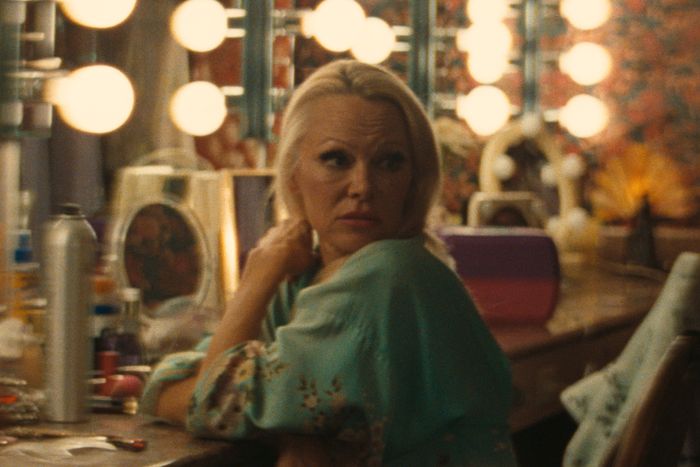
As a film, The Last Showgirl probably should have been a short. Even at only 89 minutes, the story of Shelly (Pamela Anderson), a onetime star of the Las Vegas revue show Le Razzle Dazzle, stretches out too long, not unlike the shimmery butterfly wings Shelly wears as part of her costume. One shot of Shelly twirling around silently in Las Vegas’s lights is enough to show how those neon glares threaten to overwhelm her. But director Gia Coppola returns to that image so often, in lieu of character development or forward plotting, that it becomes clear Anderson’s starring performance is more substantial than the film housing it.
Shot over 18 days, The Last Showgirl follows Shelly as she learns that Le Razzle Dazzle is ending its 38-year run on the Strip. For the teen and 20s-omething members of the revue, like Jodie (Kiernan Shipka) and Mary-Anne (Brenda Song), that means leaving the venue’s relative coziness — its producer Eddie’s (Dave Bautista, as lovely in his melancholy here as he was in Blade Runner 2049) soft-spoken paternal leadership, Shelly’s flightiness and nerves before each show — for more sexualized productions like Hedonist Delight. (One of the film’s best sight gags is Anderson’s horrified expression at the younger women acting out those twerking-and-thrusting audition routines, accompanied with choreography descriptions like “ass, ass, unh, unh, body roll.”)
Le Razzle Dazzle was a familiar if low-paying job. For Shelly, though, the show’s closing signifies something more like the end of her life. Anderson’s breathy line deliveries drip with wistful nostalgia, especially when she’s rattling off her history with the show — hired in 1987, did the show’s solo until 1999. A move to New York City didn’t take (a perfect Anderson moment is her bald read of the Rockettes: “I found all that kicking very redundant”). Instead, Shelly abandoned a marriage and her daughter, Hannah (Billie Lourd), to keep working in Vegas. Who will she be now, when the show is over and her time has seemingly run out, too?
Anderson’s casting is the film’s coup de grâce: The actress’s own experiences of being sexualized then discarded align with Shelly’s character, and she brings an earnest pride to scenes where she has to talk about her work (even the toplessness of it) that might challenge assumptions about the kind of women who take off their clothes for money. And while The Last Showgirl and The Substance, another recent movie about the invisibility of older women, share a disappointment in how quickly we cast our elders aside, The Last Showgirl leans into loneliness rather than anger, a downbeat quality that benefits Anderson’s quieter persona at this point in her career. Kate Gersten’s script keeps a lot of details about Shelly’s life vague, which gives some of her seemingly meaningful conversations, like those with Hannah, an oblique quality. Its smartest tactic, though, is how it maintains us within Shelly’s perspective, handing her chunks of dialogue about the sophistication of the show and the allure of Las Vegas that seem to be in direct contradiction with her otherwise modest life — her small home, her basic groceries, her somewhat outdated fashion sense, her lack of savings.
Her only extravagance is a movie room where she watches silent films, ballet and dance performances that she believes she’s evoking through Le Razzle Dazzle. (Coppola and cinematographer Autumn Durald Arkapaw’s decision to shoot on film really pays off in that interior; Shelly’s lace-and-velvet room looks ancient and beautiful in the film grain.) Whether Shelly is optimistic or delusional in comparing herself to those era’s icons is for us to decide: Is it a desire for fame that kept her in this gig, or a sincere belief that she’s an artist? If it’s the latter, is her passion somehow less worthwhile because she’s in a Vegas revue show rather than on Broadway?
Coppola’s previous film, 2021’s Mainstream, which starred Andrew Garfield as an outsider who becomes a popular YouTube influencer and Maya Hawke as his increasingly wary producer, also questioned which forms of creativity we value and which we dismiss. The Last Showgirl has a softer core than that film, but its obsession with whether art needs to be commercially successful or broadly popular to be considered worthwhile is similar enough to Mainstream’s guiding question that it feels like Coppola, as the third generation of one of America’s most enduring cinema families, is working through something. (Her reactions to her grandfather Francis’s Megalopolis, perhaps?) Maybe that’s also why The Last Showgirl feels like it meanders, with all those sequences of Shelly walking the Strip, her circular conversations with her friends and family, and a lengthy scene in which her best friend, Annette (played by an overacting Jamie Lee Curtis), dances by herself on a casino tabletop to Bonnie Tyler’s “Total Eclipse of the Heart.” There’s a certain socially acceptable answer to this question of whether someone, especially a woman and mother, should single-mindedly devote themselves to their passion. Neither Coppola nor Gersten wants to accept the answer — which is both sympathetic to Shelly and Anderson’s performance, but detrimental to the film at large. The Last Showgirl is reluctant to abandon the limelight. Amid its hesitation for resolution, though, it proves how much more Anderson has left to give.
More Movie Reviews
- The Accountant 2 Can Not Be Taken Seriously
- Another Simple Favor Is So Fun, Until It Gets So Dumb
- Errol Morris Has Been Sucked Into the Gaping Maw of True Crime


